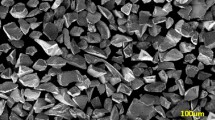Abstract
Uniaxial fatigue damage analyses were performed on borosilicate glass-ceramic matrix, Nicalon (silicon carbide) fibre reinforced unidirectional composites. The fibre volume fraction varied from about 0.25 to 0.60. Load-controlled tension-tension fatigue tests (R ratio = 0.1) were conducted at room temperature and 540°C (1000°F). The fatigue life was found to decrease with increasing cyclic stress level and a power-law relationship of the form σapp = σuts(2N f)b was established where σapp is the applied maximum stress, σuts the monotonic tensile strength, N f is the number of cycles to failure and b is the fatigue strength exponent. The fatigue damage evolution manifested itself as a decrease in stiffness of the composite with fatigue cycles. This stiffness drop was associated with matrix cracking followed by fibre-matrix debonding and fibre sliding breakage/pull-out, and final failure, respectively at 540°C. The damage evolution at room temperature was associated with degradation of the matrix followed by steady breakage of fibres with no debonding/pull-out, leading to eventual failure of the net section of the composite. In general, quantitative microscopic observations of debonded and pulled-out fibres showed a good correlation with the observed reduction in stiffness. A predictive model to interpret the drop in stiffness is presented and validated using experimental results from the current study.
Similar content being viewed by others
References
K. M. PREWO, J. J. BRENNAN and G. K. LAYDEN, Ceram. Bull. 65 (1986) 305.
K. M. PREWO, ibid. 68 (1989) 395.
K. M. PREWO et al., J. Mater. Sci. 24 (1989) 1373.
K. M. PREWO and J. J. BRENNAN, ibid. 15 (1980) 463.
K. M. PREWO and E. R. THOMPSON “Research on Graphite Reinforced Glass Matrix Composites”, NASA CR 165711(1981).
L. M. BUTKUS, L. P. ZAWADA and G. A. HARTMAN in Proceedings of Aero Mat'90, Advanced Aerospace Materials/Processes Conference, Long Beach, California, May 1990, in press.
K. M. PREWO, J. Mater. Sci. 22 (1987) 2965.
V. S. AVVA and J. SANKAR, “Effect of Thermal and Cyclic Loads on Silicon Carbide Yarn Reinforced Glass Matrix Composites”, Final Report, DoE Contract DE-FG05-84ER45140, (1989).
T. KOTIL, J. W. HOLMES and M. COMNINOU, J. Amer. Ceram. Soc. 73 (1990) 1879.
V. RAMAKRISHNAN and N. Jayaraman, J. Mater. Sci. in press.
W. HWANG and K. S. HAN, J. Compos. Mater. 20 (1986) 154.
V. RAMAKRISHNAN and N. Jayaraman, submitted.
J. D. BRIGHT, S. DANCHAIVIJIT and D. K. SHETTY, J. Amer. Ceram. Soc. 74 (1991) 115.
Author information
Authors and Affiliations
Rights and permissions
About this article
Cite this article
Ramakrishnan, V., Jayaraman, N. Fatigue behaviour of borosilicate glass-ceramic matrix, nicalon (silicon carbide) fibre composites. JOURNAL OF MATERIALS SCIENCE 28, 5580–5591 (1993). https://doi.org/10.1007/BF00367834
Received:
Accepted:
Published:
Issue Date:
DOI: https://doi.org/10.1007/BF00367834




